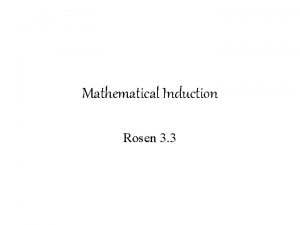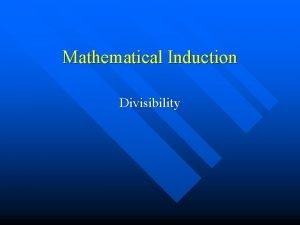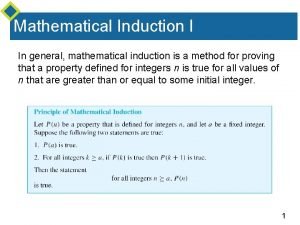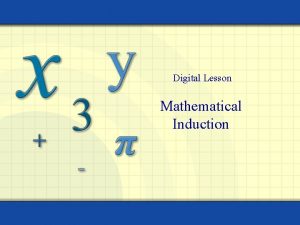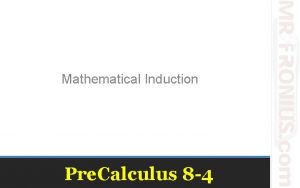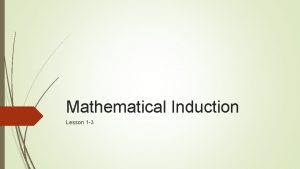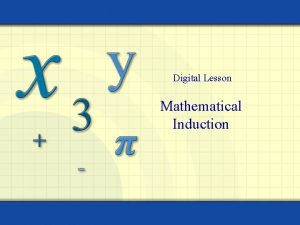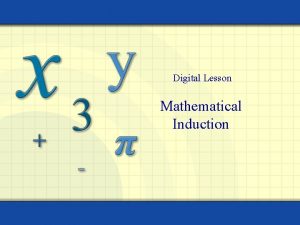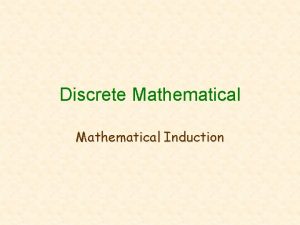Mathematical Induction 1 Mathematical Induction Example Show that












- Slides: 12

Mathematical Induction 1

Mathematical Induction: Example Ø Show that any postage of ≥ 8¢ can be obtained using 3¢ and 5¢ stamps. Ø First check for a few particular values: 8¢ = 3¢ + 5¢ 9¢ = 3¢ + 3¢ 10¢ = 5¢ + 5¢ 11¢ = 5¢ + 3¢ 12¢ = 3¢ + 3¢ Ø How to generalize this? 2

Mathematical Induction: Example • Let P(n) be the sentence “n cents postage can be obtained using 3¢ and 5¢ stamps”. • Want to show that “P(k) is true” implies “P(k+1) is true” for any k ≥ 8¢. • 2 cases: 1) P(k) is true and the k cents contain at least one 5¢. 2) P(k) is true and the k cents do not contain any 5¢. 3

Mathematical Induction: Example • Case 1: k cents contain at least one 5¢ coin. Replace 5¢ coin by two 3¢ coins k cents 5¢ k+1 cents 3¢ 3¢ • Case 2: k cents do not contain any 5¢ coin. Then there at least three 3¢ coins. k cents 3¢ 3¢ 3¢ Replace three 3¢ coins by two 5¢ coins k+1 cents 5¢ 5¢ 4

Domino Effect • Mathematical induction works like domino effect: • Let P(n) be “The nth domino falls backward”. • If (a) “P(1) is true”; (b) “P(k) is true” implies “P(k+1) is true” Then P(n) is true for every n 5

Principle of Mathematical Induction Let P(n) be a predicate defined for integers n. Suppose the following statements are true: 1. Basis step: P(a) is true for some fixed a Z. 2. Inductive step: For all integers k ≥ a, if P(k) is true then P(k+1) is true. Then for all integers n ≥ a, P(n) is true. 6

Example: Sum of Odd Integers Ø Proposition: 1 + 3 + … + (2 n-1) = n 2 for all integers n≥ 1. Ø Proof (by induction): 1) Basis step: The statement is true for n=1: 1=12. 2) Inductive step: Assume the statement is true for some k≥ 1 (inductive hypothesis) , show that it is true for k+1. 7

Example: Sum of Odd Integers Ø Proof (cont. ): The statement is true for k: 1+3+…+(2 k-1) = k 2 (1) We need to show it for k+1: 1+3+…+(2(k+1)-1) = (k+1)2 (2) Showing (2): 1+3+…+(2(k+1)-1) = 1+3+…+(2 k+1) = by (1) 1+3+…+(2 k-1)+(2 k+1) = k 2+(2 k+1) = (k+1)2. We proved the basis and inductive steps, so we conclude that the given statement true. ■

Important theorems proved by mathematical induction Ø Theorem 1 (Sum of the first n integers): For all integers n≥ 1, Ø Theorem 2 (Sum of a geometric sequence): For any real number r except 1, and any integer n≥ 0, 9

Example (of sum of the first n integers) Ø In a round-robin tournament each of the n teams plays every other team exactly once. What is the total number of games played? Solution on the board. 10

Proving a divisibility property by mathematical induction • Proposition: For any integer n≥ 1, 7 n - 2 n is divisible by 5. (P(n)) • Proof (by induction): 1) Basis step: The statement is true for n=1: (P(1)) 71 – 21 = 7 - 2 = 5 is divisible by 5. 2) Inductive step: Assume the statement is true for some k≥ 1 (P(k)) (inductive hypothesis) ; show that it is true for k+1. (P(k+1)) 11

Proving a divisibility property by mathematical induction Ø Proof (cont. ): We are given that P(k): 7 k - 2 k is divisible by 5. (1) Then 7 k - 2 k = 5 a for some a Z. (by definition) (2) We need to show: P(k+1): 7 k+1 - 2 k+1 is divisible by 5. (3) 7 k+1 - 2 k+1 = 7· 7 k - 2· 2 k = 5· 7 k + 2·(7 k - 2 k) = 5· 7 k + 2· 5 a (by (2)) = 5·(7 k + 2 a) which is divisible by 5. (by def. ) Thus, P(n) is true by induction. ■ 12
 Ngoại tâm thu thất chùm đôi
Ngoại tâm thu thất chùm đôi Premature atrial contraction
Premature atrial contraction Thể thơ truyền thống
Thể thơ truyền thống Thơ thất ngôn tứ tuyệt đường luật
Thơ thất ngôn tứ tuyệt đường luật Chiến lược kinh doanh quốc tế của walmart
Chiến lược kinh doanh quốc tế của walmart Tìm vết của mặt phẳng
Tìm vết của mặt phẳng Hãy nói thật ít để làm được nhiều
Hãy nói thật ít để làm được nhiều Tôn thất thuyết là ai
Tôn thất thuyết là ai Gây tê cơ vuông thắt lưng
Gây tê cơ vuông thắt lưng Sau thất bại ở hồ điển triệt
Sau thất bại ở hồ điển triệt Strong mathematical induction
Strong mathematical induction Mathematical induction
Mathematical induction Mathematical induction divisibility
Mathematical induction divisibility










